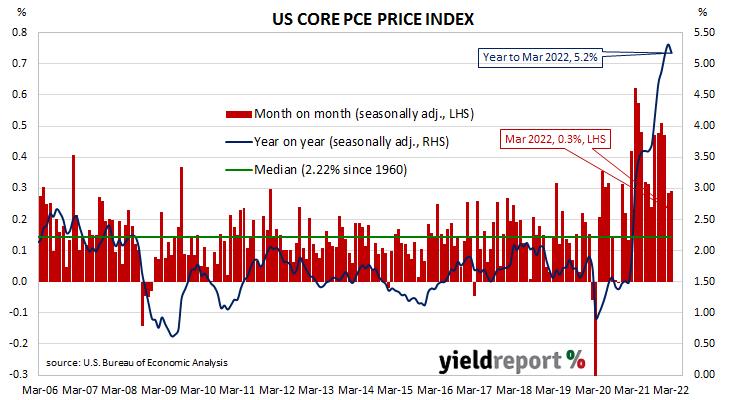Summary: US core PCE price index up 0.3% in March; in line with expectations; annual rate slows from 5.3% to 5.2%; first slowing of annual rate since October 2020, more expected; Treasury yields up considerably; nearly 275bps of Fed rate rises priced in.
One of the US Fed’s favoured measures of inflation is the change in the core personal consumption expenditures (PCE) price index. After hitting the Fed’s target at the time of 2.0% in mid-2018, the annual rate then hovered in a range between 1.8% and 2.0% before it eased back to a range between 1.5% and 1.8% through 2019. It then plummeted below 1.0% in April 2020 before rising back to around 1.5% in the September quarter of that year. It has since ran up well above the Fed’s target.
The latest figures have now been published by the Bureau of Economic Analysis as part of the March personal income and expenditures report. Core PCE prices rose by 0.3% over the month, in line with expectations as well as February’s increase after it was revised down. On a 12-month basis, the core PCE inflation rate slowed from February’s revised figure of 5.3% to 5.2%.
NAB currency strategist Rodrigo Catril noted it was the first decline in the annual rate since October 2020 and “more of the same is expected with base effects remaining favourable over coming months.” ANZ Head of Australian Economics David Plank echoed this sentiment, noting “these price increases were stronger earlier in the quarter, indicating inflation may have peaked.”
US Treasury bond yields increased considerably on the day. By the close of business, the 2-year Treasury bond yield had gained 9bps to 2.72%, the 10-year yield had added 11bps to 2.94% while the 30-year yield finished 10bps higher at 3.00%.
In terms of US Fed policy, expectations of a higher federal funds rate over the next 12 months firmed. At the close of business, May contracts implied an effective federal funds rate of 0.785%, 45bps higher than the current spot rate. August contracts implied a rate of 1.93% and March 2023 futures contracts implied 3.055%, nearly 275bps above the spot rate.
The core version of PCE strips out energy and food components, which are volatile from month to month, in an attempt to identify the prevailing trend. It is not the only measure of inflation used by the Fed; the Fed also tracks the Consumer Price Index (CPI) and the Producer Price Index (PPI) from the Department of Labor. However, it is the one measure which is most often referred to in FOMC minutes.


